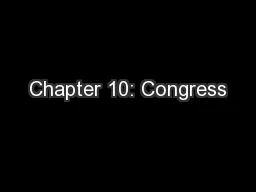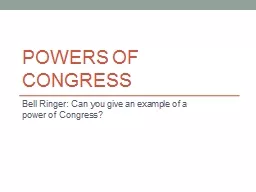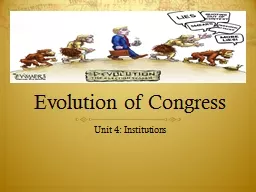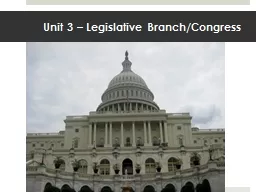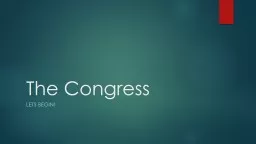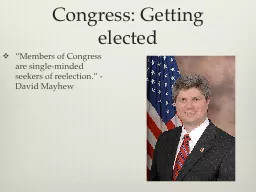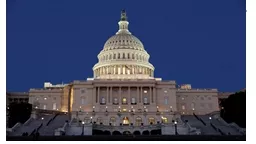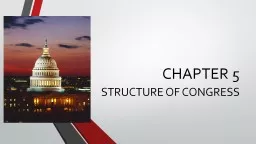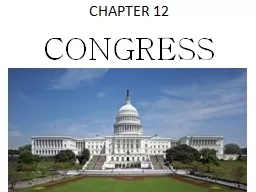PPT-Chapter 10: Congress
Author : mitsue-stanley | Published Date : 2017-04-16
The National Legislature Chapter 10 Section 1 Who are They Quiz 1 Name two of the three reasons that the book identifies for why the Constitution establishes a bicameral
Presentation Embed Code
Download Presentation
Download Presentation The PPT/PDF document "Chapter 10: Congress" is the property of its rightful owner. Permission is granted to download and print the materials on this website for personal, non-commercial use only, and to display it on your personal computer provided you do not modify the materials and that you retain all copyright notices contained in the materials. By downloading content from our website, you accept the terms of this agreement.
Chapter 10: Congress: Transcript
The National Legislature Chapter 10 Section 1 Who are They Quiz 1 Name two of the three reasons that the book identifies for why the Constitution establishes a bicameral legislature 2 How many sessions of Congress are there in one year. And 57375en 57375ere Were None meets the standard for Range of Reading and Level of Text Complexity for grade 8 Its structure pacing and universal appeal make it an appropriate reading choice for reluctant readers 57375e book also o57373ers students Bell Ringer: . Can you give an example of a power of Congress?. Delegated Powers. Congressional powers are delegated . (given) by the Constitution.. These delegated powers are either . 1.) Expressed 2.)Implied or 3.) Inherent . Unit 4: Institutions. I. Intention of Founders. Fear of excessive power concentrated in single institution. Fear of mob rule by impassioned majority. Concern about manner of . representation. in Congress. Review. The differences between the House and Senate are… . The differences between the House and Senate are… . Size and representation to begin with, in the House you get one hour to debate, the Senate gets unlimited debate (filibuster) which can only be stopped by a cloture vote (60 votes), spending bills must originate in the House.. The Capitol Building. The Capitol Building. Main Ideas. Congress is . bicameral. , meaning divided into two houses/chambers.. In the House of Representatives, the States are represented according to population.. europe. Chapter 23.5. What was the Congress of Vienna?. First Question:. The Congress of Vienna was a series of meetings of European heads of government looking to establish long-lasting peace and stability in Europe after the defeat of Napoleon.. Bell Ringer: . Give two examples of POWERS OF CONGRESS:. Delegated Powers. Congressional powers are . delegated (given) . by the Constitution.. These delegated powers are either . 1. .) Expressed . 2. Lets Begin!. Introduction:. Public approval of Congress is very low. Yet, approval ratings for people’s representative is high . Members spend considerable time serving constituents . Functions of Congress:. “Members of Congress are single-minded seekers of reelection.” - David Mayhew. Congress: Getting elected. Incumbency Advantage. Between 1863 and 1969 percentage of first term Reps. fell from about 58% to 8. Senator Sumner- Massachusetts. Gave a speech to Congress about evil pro-slavery Kansas supporters. Offended Senator Brooks . Brooks attacked Sumner with his cane over 30 times in the Senate. . “The Crime Against Kansas”. LESSON OBJECTIVES. EXPLAIN BASIC DIFFERENCES BETWEEN CONGRESS AND THE BRITISH PARLIAMENT. DISCUSS HOW CONGRESS REFLECTS AMERICA’S COMMITMENT TO RESPRESENTATIVE GOVERNMENT AND FEDERALISM. IDENTIFY SEVERAL CONSTITUTIONAL SOURCES OF CONGRESSIONAL POWER. Lesson 1: Congressional Membership. ESSENTIAL QUESTION:. What is the structure and organization of Congress?. Organization of Congress. Founders gave more power to Congress than to any other branch.. Congress – Ended Jan 3, 2013. 113. th. Congress – Current. (ends January 3, 2015). The House of Representatives. In the . House of Representatives there are . 232 . Republicans. , . 199 Democrats. Why is Article I so long and Articles II and III so short? What does this reveal about the Framers view of Congress?. Evolution of congress. Intentions of founders. Fear of excessive power concentrated in a single institution.
Download Document
Here is the link to download the presentation.
"Chapter 10: Congress"The content belongs to its owner. You may download and print it for personal use, without modification, and keep all copyright notices. By downloading, you agree to these terms.
Related Documents

